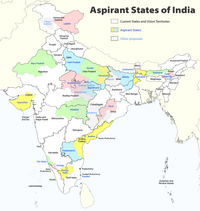Kodagu district (Kodava: [koɖɐɡɨ]) (also known by its former name Coorg) is an administrative district in the Karnataka state of India. Before 1956, it was an administratively separate Coorg State at which point it was merged into an enlarged Mysore State.

Geography
Kodagu is located on the eastern slopes of the Western Ghats. It has a geographical area of 4,102 km (1,584 sq mi). The district is bordered by Dakshina Kannada district to the northwest, Hassan district to the north, Mysore district to the east, Kasaragod district of Kerala in west and Kannur district of Kerala to the southwest, and Wayanad district of Kerala to the south. It is a hilly district, the lowest elevation being 50 metres (160 ft) above sea-level near makutta. The highest peak, Tadiandamol, rises to 1,750 metres (5,740 ft), with Pushpagiri, the second highest, at 1,715 metres (5,627 ft). The main river in Kodagu is the Kaveri (Cauvery), which originates at Talakaveri, located on the eastern side of the Western Ghats, and with its tributaries, drains the greater part of Kodagu.
Rivers (mouth)
- Kaveri (Bay of Bengal)
- Payaswini (Arabian Sea)
- Tejaswini (Arabian Sea)
- Kuppam River (Arabian Sea)
- Valapattanam River (Arabian Sea)
- Harangi (Kaveri)
- Lakshmana Tirtha (Kaveri)
- Barapole (Valapattanam River)
- Kumaradhara (Netravathi River)
Peaks
Rainfall
Kodagu district receives majority of its rainfall from Southwest Monsoon winds. It is the 4th highest average annual rainfall receiving district in Karnataka. The amount of rainfall varies significantly due to the effects of El-nino and La-nina.
In the year 2018, Kodagu received 29% excess rainfall of 3,737 millimetres (147.1 in), 3,040 millimetres (120 in) in 2019, 2,541 millimetres (100.0 in) in 2020, and 2,656 millimetres (104.6 in) in 2021.
In the year 2022, Kodagu received 11% Above-Normal rainfall of 3,036 millimetres (119.5 in).
In the year 2023, it received 38% deficit rainfall of 1,690 millimetres (67 in).
Forest
Kodagu is known for its dense forest cover and the exotic flora and fauna found there. It has three wildlife sanctuaries; Pushpagiri Wildlife Sanctuary, Talakaveri Wildlife Sanctuary and Brahmagiri Wildlife Sanctuary, one National Park; the Nagarahole National Park and the only private sanctuary of India; the SAI Sanctuary.
Kodagu is home for species endemic to the Western Ghats. It has large tiger and elephant populations as well. As per the elephant census of 2023, Kodagu with 1,013 elephants, had nearly one-sixth of total elephant population in Karnataka, second only to Chamarajanagar.
Agriculture
Economy of Kodagu is dependent on agriculture. Major crops grown here are Paddy, Coffee, Rubber, Pepper, Cardamom, Coorg Oranges and Honey production. Tea, Ginger and Cocoa are also grown in smaller quantities.
Coffee and pepper production
Kodagu is the largest Coffee and Pepper producing district in India. Karnataka produces nearly 70% of the total Coffee production in India, out of which 33% is contributed by Kodagu district alone. Also Kodagu produces nearly a quarter of India's Black Pepper.
Representation
Two members of the legislative assembly are elected from Kodagu to the Karnataka Legislative Assembly, one each from the Madikeri and Virajpet. Dr. Mantar Gowda represents the Madikeri constituency while A.S Ponnanna represents the Virajpet constituency; they are from the Indian National Congress. Kodagu, formerly part of the Kodagu-Dakshina Kannada (Mangalore) constituency, is now part of the Mysore-Kodagu Lok Sabha constituency parliamentary constituency. The current MP for this constituency is Shri Yaduveer Krishnadatta Chamaraja Wadiyar, from the Bharatiya Janata Party.
The Codava National Council and Kodava Rashtriya Samiti are campaigning for autonomy to Kodagu district which would have made Coorg more prosperous and independent.
History

The Kodavas were the earliest inhabitants and agriculturists in Kodagu, having lived there for centuries. Kodavas being a warrior community as well, they carried arms during times of war and had their own chieftains.
The earliest mention about Coorg can be seen in the works those date back to Sangam period (300 BCE - 300 CE). The Ezhimala dynasty had jurisdiction over two Nadus - The coastal Poozhinadu and the hilly eastern Karkanadu. According to the works of Sangam literature, Poozhinadu consisted much of the coastal belt between Mangalore and Kozhikode. Karkanadu consisted of Wayanad-Gudalur hilly region with parts of Kodagu (Coorg).
The Haleri dynasty, an offshoot of the Keladi Nayakas, ruled Kodagu between 1600 and 1834. Later the British ruled Kodagu from 1834, after the Coorg War, until India's independence in 1947. A separate state (called Coorg State) until then, in 1956 Kodagu was merged with the Mysore State (now Karnataka).
Coorg in British India
In 1834, the East India Company annexed Kodagu into British India, after deposing Chikka Virarajendra of the Kodagu kingdom, as 'Coorg'. British rule led to the establishment of educational institutions, introduction of scientific coffee cultivation, better administration and improvement of the economy. This reference notwithstanding - we should remember that the colonial rule by the British in India was about exploitation of resources and Kodagu provided a lot of scope for economic benefits to a colonising empire.
Demographics
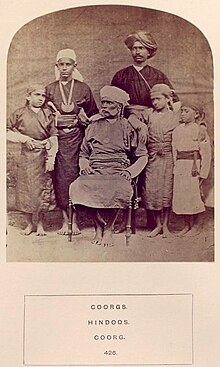
| Year | Pop. | ±% p.a. |
|---|---|---|
| 1901 | 180,607 | — |
| 1911 | 174,976 | −0.32% |
| 1921 | 163,838 | −0.66% |
| 1931 | 163,327 | −0.03% |
| 1941 | 168,726 | +0.33% |
| 1951 | 229,405 | +3.12% |
| 1961 | 322,829 | +3.48% |
| 1971 | 378,291 | +1.60% |
| 1981 | 461,888 | +2.02% |
| 1991 | 488,455 | +0.56% |
| 2001 | 548,561 | +1.17% |
| 2011 | 554,519 | +0.11% |
| source: | ||
According to the 2011 census of India, Kodagu has a population of 554,519, roughly equal to the Solomon Islands or the US state of Wyoming. This ranks it 539 out of 640 districts in India in terms of population. The district has a population density of 135 inhabitants per square kilometre (350/sq mi). Its population growth rate over the decade 2001–2011 was 1.13%. Kodagu has a sex ratio of 1019 females for every 1000 males, and a literacy rate of 82.52%. 14.61% of the population lives in urban areas. Scheduled Castes and Scheduled Tribes make up 13.27% and 10.47% of the population respectively.
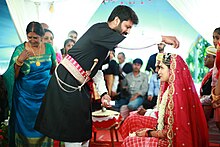
Religion
Hindus are the vast majority. They include the Kodava people, other Kodava language speakers, Arebhashe Gowdas, Brahmins, most Yeravas and Kurubas. A huge minority of Muslims dot the Coorg district, especially the towns of Kushalnagar, Virajpet and Mercara. A sizeable of them are the Nawayaths who shifted in the eighties from Bhatkal and Murdeshwar in order to pursue coffee & arecanut plantations and textile business. The numerous mosque dotting the landscape is the testimony of Muslim presence in the district.
A small number of Mangalorean Catholics are also found in Coorg. They are mostly descended from those Konkani Catholics who fled the roundup and, later, captivity by Tippu Sultan. These immigrants were welcomed by Raja Veerarajendra (himself a former captive of Tippu Sultan, having escaped six years of captivity in 1788) who realising their usefulness and expertise as agriculturists, gave them lands and tax breaks and built a church for them.
Language
At the time of the 2011 census, 30.91% of the population spoke Kannada, 20.83% Malayalam, 14.86% Kodava, 8.92% Tulu, 5.81% Are, 4.66% Yerava, 4.23% Tamil, 2.95% Urdu, 1.74% Kurumba, 1.55% Telugu and 1.16% Konkani as their first language.
Are Bhashe, a dialect of Kannada, Tulu and Kodava language are native to Kodagu district. Kodava Language uses the Official Script Invented by Dr IM Muthanna in 1970.
Kodava people and other Kodava language speakers
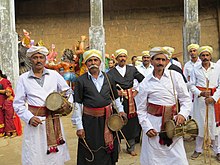
According to Karnataka Kodava Sahitya Academy (Karnataka's Kodava Literary Academy), apart from Kodavas, and their related groups, the Amma Kodavas, the Kodava Peggade (Kodagu Heggade) and the Kodava Maaple (Kodava Muslims), 18 other smaller-numbered ethnic groups speak Kodava Takk in and outside the district including the Iri (Airi, or the carpenters and the village smiths), the Koyava, the Banna, the Kodagu Madivala (washermen), the Kodagu Hajama (barber, also called Nainda), the Kembatti Poleya (household servants and labourers) and the Meda (basket and mat weavers and drummers).
Among other Kodava speaking communities are: the Heggades, cultivators from shimogga; the Kodava Nair, cultivators from Kerala State; the Ayiri, who constitute the artisan caste; the Medas, who are basket and mat-weavers and act as drummers at feasts; the Binepatta, originally wandering musicians from Malabar, now farmers; and the Kavadi, cultivators settled in Yedenalknad (Virajpet). All these groups speak the Kodava language and conform generally to Kodava customs and dress.
Kodagu Aarebashe Gowda
Less frequent are Tulu speakers Billavas, Mogaveeras, Bunts, Goud Saraswat Brahmins.
The Arebhashe gowdas, or Kodagu Gowdas, and Tulu Gowdas, are an ethnic group of Dakshina Kannada and Kodagu. They live in Sulya (in Dakshina Kannada) and in parts of Somwarpet, Kushalanagar, Bhagamandala and Madikeri. They speak a language known as Arebhashe a dialect of Kannada. Guddemane Appaiah Gowda along with many other freedom fighters from different communities revolted against the British in an armed struggle which covered entire Kodagu and Dakshina Kannada. This was one of the earliest freedom movements against the British called "Amara Sulliada Swantantrya Sangraama" (Amara Sulya Dhange formally called the 'Coorg Rebellion' by the British) started in 1837.
Tourism
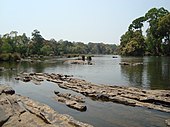

Kodagu is rated as one of the top hill station destinations in India. Some of the most popular tourist attractions in Kodagu include Talakaveri, Bhagamandala, Nisargadhama, Abbey Falls, Dubare, Nagarahole National Park, Iruppu Falls, and the Tibetan Buddhist Golden Temple.
- Talakaveri is the place where the River Kaveri originates. The temple on the riverbanks here is dedicated to Lord Brahma, and is one of only two temples dedicated to Brahma in India and Southeast Asia. Bhagamandala is situated at the Sangama (confluence) of two rivers, the Kaveri and the Kannika. A third river, the Sujyothi, is said to join from underground, and hence this spot is called the Triveni Sangama. Iruppu Falls is a sacred Kodagu Hindu spot in South Kodagu in the Brahmagiri hill range. The Lakshmana Tirtha River, with the waterfalls, flows nearby and has a Rameshwara temple on its banks. It is said that this sacred river was created when Laxmana, prince of Ayodhya and younger brother of Lord Rama, shot an arrow into nearby hill, the Brahmagiri hill. Chelavara falls and Thadiandamol peak are also in South Kodagu. Nagarahole is a national park and wildlife resort.
- Madikeri is the capital of the district and Raja's Seat park is popular with tourists. Kootu Poley dam is also popular among tourists. Omkareshwara Temple is a beautiful temple built in the Indo-Sarcenic style in Coorg. A legend is associated with the temple, built by Lingarajendra II in 1820 CE. The king put to death a pious Brahmin who dared to protest against his misdeeds. The spirit of the dead man began to plague the king day and night. On the advice of wise men, the king built this temple and installed a Shivalinga procured from Kashi, North India. St. Mark's Church is located within the Mercara Fort and was raised in 1859, by the officers and men of the East India Company. The building was funded by the Government of Madras, and placed under the Church of England in India, Diocese of Madras. The Church was closed after Indian independence, and taken over by the Government of Karnataka in 1971. The building now houses the Madikeri Fort Museum, managed by the Karnataka State Archaeological Department.
- Dubare is mainly an elephant-capturing and training camp of the Forest Department at the edge of Dubare forest; on the bank of the river Kaveri along the Kushalanagara – Siddapura road. Nisargadhama is a man-made island and picnic spot near Kushalanagara, formed by the river Kaveri. The Tibetan Buddhist Golden Temple is at Bylakuppe near Kushalnagara (Mysore district), in the Tibetan refugee settlement.
- Abbey Falls is a scenic waterfall 5 km from Madikeri. Mallalli falls is 25 km from Somawarapet, downhill of the Pushpagiri hills. Mandalapatti is 28 km from Madikeri. On the way to Abbey Falls, before 3 km from Abbey Falls take right, from there 25 km. Kote Betta temple, Kote Abbey falls are also in North Kodagu. Abbi waterfall and other waterfalls are best during monsoon season, typically some days after it starts raining in June up to the end of rainy season, while there is more water gushing in the streams and rivers.
Notable people
Armed Forces
- Air Marshal K. C. Cariappa
- Field Marshal K. M. Cariappa, first Indian C-in-C, fourth Indian High Commissioner to Australia and New Zealand
- Squadron Leader Ajjamada Boppayya Devayya, martyred in Indo-Pak war of 1965 as a fighter pilot after shooting down enemy aircraft and crashing into Pakistan; only Indian Air Force personnel to earn the Mahavir Chakra posthumously
- Major Mangerira Chinnappa Muthanna Army Martyr
- Lieutenant General Biddanda Chengappa Nanda, GOC-in-C Northern Command, Karnataka Rajyothsava Awardee
- Lieutenant General C.B. Ponnappa, Adjutant General of the Indian Army.
- General Kodandera Subayya Thimayya, head of Indian Army, chairman of Korean Repatriation Commission, head of UN Peacekeeping force
- Lieutenant General Pattacheruvanda C. Thimayya, former General Officer in the Indian Army
Sports
- Len Aiyappa - Indian field hockey player.
- Neravanda Aiyappa - Cricketer
- K. P. Appanna - Cricketer
- Rohan Bopanna, Indian tennis player
- K. C. Cariappa, professional cricketer
- Joshna Chinappa - Indian squash player
- M. P. Ganesh (Mollera Poovaiah Ganesh), Indian hockey captain, player and coach
- B. P. Govinda (Billimoga Puttaswamy Govinda), Indian hockey player
- Arjun Halappa, Indian hockey captain and player
- Ashwini Nachappa, Indian athlete, Arjuna awardee
- Jagat and Anita Nanjappa - motor racers
- Ashwini Ponnappa, Indian badminton player
- V. R. Raghunath (Vokkaligara Ramachandra Raghunath), Indian hockey player
- M. M. Somaya (Maneyapanda Muthanna Somaya) - Indian field hockey player.
- A. B. Subbaiah (Anjaparavanda Bopaiah Subbaiah) - Indian field hockey goalkeeper and coach.
- S. V. Sunil (Somwarpet Vittalacharya Sunil), Indian hockey player
- Robin Uthappa, Indian Cricketer
Politics
- K. G. Bopaiah (Kombarana Ganapathy Bopaiah), 18th Speaker of the Karnataka Legislative Assembly
- Prema Cariappa, first woman Mayor of Bangalore, Rajya Sabha MP
- Mantar Gowda
- Gundugutti Manjanathaya, freedom fighter and politician
- A. S. Ponnanna, Virajpet MLA
- C M Poonacha (Cheppudira Muthanna Poonacha) Gandhian, Freedom fighter, politician.
- Appachu Ranjan, politician
- R. Gundu Rao, Chief Minister of Karnataka
- N. Somanna (Nidyamale Somanna), lawyer and politician
Cinema
- Daisy Bopanna, actress
- Shwetha Chengappa, actress
- Gulshan Devaiah
- Rashmika Mandanna, actress
- Harshika Poonacha, actress
- Prema, actress
- Nidhi Subbaiah, actress
Civil Services
- A. S. Bopanna, Judge of Supreme court
- Diwan Bahadur Ketoli Chengappa, administrator (Chief Commissioner of Coorg province)
- B. B. Ashok Kumar, Retd. Assistant Commissioner of Police of Bengaluru
- P. K. Monnappa, first Inspector General of Police of Hyderabad State following Operation Polo
- C. B. Muthamma, first woman officer Indian Foreign Service
- C. G. Somiah was the first IAS Officer from Coorg to rise to be the Home Secretary, Chief Vigilance Commissioner (CVC) and Comptroller and Auditor General.
Religion
- Swami Narayanananda
- Kalyatanda Ponnappa (c.1600) was a religious leader and warrior who is now worshipped as a demi-god
- Swami Shambhavananda
- Appayya Swamigalu (1885–1956), (born of Kodava parents) founder of Kaveri Ashram, a Hindu monastery in Virajpet, born as Palanganda Appaiah, ordained into Sannyas (monkhood) by Guru Ramgiri.
Literature
- Nadikerianda Chinnappa, folklore compiler
- B D Ganapathy
- Appachcha Kavi (also called Appachu Kavi), playwright
- I. M. Muthanna author and translator
- Boverianda Nanjamma and Chinnappa, translators, authors
Others
- Pandyanda Belliappa (also called Pandianda Belliappa or P I Belliappa) Gandhian, Freedom fighter, politician, journalist.
- Biddu is a Kodava (Coorgi) by birth. He is a British Indian musician and winner of Grammy award.
- Saleem Farook, tribal rights activist
- Guddemane Appaiah Gowda, 19th century freedom fighter
- Kodagina Gowramma, noted writer
- N. S. Narendra, Firepro founder
- Nima Poovaya-Smith, museum curator, art historian and writer
See also
References
- ^ "Kodagu district Profile". DSERT. Retrieved 11 January 2011.
- ^ "District Census Handbook: Kodagu" (PDF). censusindia.gov.in. Registrar General and Census Commissioner of India. 2011.
- ^ "Kodagu District Population Census 2011-2021, Karnataka literacy sex ratio and density".
- ^ Kushalappa, Mookonda (2013). Long ago in Coorg. USA. pp. 356–365. ISBN 9781494282479.
{{cite book}}: CS1 maint: location missing publisher (link) - ^ Ponnathpur, Rakshith S. (12 August 2020). "When Kodagu merged with Mysore: A short political history of the region". The News Minute. Retrieved 18 December 2024.
- ^ "Districts of India". Government of India. Retrieved 11 January 2011.
- ^ "Coorg Gazettee 1870". Retrieved 21 July 2024.
- ^ "Annual State Report 2018" (PDF). Retrieved 31 July 2024.
- ^ "Annual State Report 2019" (PDF). Retrieved 31 July 2024.
- ^ "Annual State Report 2020" (PDF). Retrieved 31 July 2024.
- ^ "Annual State Report 2021" (PDF). Retrieved 31 July 2024.
- ^ "Annual State Report 2022" (PDF). Retrieved 30 July 2024.
- ^ "Annual State Report 2023" (PDF). Retrieved 30 July 2024.
- ^ "Kodagu Land Use data". Retrieved 28 June 2023.
- ^ "Paddy in Kodagu". Retrieved 28 June 2023.
- ^ "Beekeeping in Kodagu". 30 June 2018. Retrieved 28 June 2023.
- ^ "Spices production in India" (PDF). Retrieved 28 June 2023.
- ^ "Coffee Production in Kodagu". Retrieved 28 June 2023.
- ^ "Kodagu of Karnataka becomes leading Pepper producer". 16 October 2017. Retrieved 28 June 2023.
- ^ "Indigenous species of Black Pepper native to Kodagu". Retrieved 28 June 2023.
- ^ "Codava National Council sets up global forum". The Hindu. Archived from the original on 3 January 2013.
- ^ "Dharna staged for Kodagu State". The Hindu. Archived from the original on 3 January 2013.
- ^ Kushalappa, Mookonda (2013). The early Coorgs. Chennai: Notion Press. ISBN 9789383808274.
- ^ A Shreedhara Menon, A Survey of Kerala history
- ^ District Census Handbook, Kasaragod (2011) (PDF). Thiruvananthapuram: Directorate of Census Operation, Kerala. p. 9.
- ^ Government of India (2014–15). District Census Handbook – Wayanad (Part-B) 2011 (PDF). Directorate of Census Operations, Kerala.
- ^ "When Kodagu merged with Mysore: A short political history of the region". The News Minute. 12 August 2020.
- ^ Kushalappa, Mookonda (2018). 1785 Coorg. Madikeri, Kodagu: Codava Makkada Coota. ISBN 9788192914220.
- ^ Kushalappa, Mookonda (2018). Kodagu principality vs British Empire. Madikeri, Kodagu: Codava Makkada Coota. ISBN 9788192914213.
- ^ Kushalappa, Mookonda Nitin (2018). Kodagu principality vs British Empire. Madikeri, Kodagu: Codava Makkada Coota. pp. 64–81. ISBN 9788192914213.
- ^ Belliappa, C P (4 August 2015). "Call for freedom from a tiny village". Deccan Herald. No. Bangalore. Retrieved 7 August 2015.
- ^ Kushalappa, Mookonda Nitin (2018). Kodagu principality vs British Empire. Madikeri, Kodagu: Codava Makkada Coota. pp. 81–88. ISBN 9788192914213.
- ^ Kushalappa, Mookonda (2014). Long ago in Coorg. Chennai: Pothi books. pp. 170–319. ISBN 9788192914206.
- ^ Decadal Variation In Population Since 1901
- ^ US Directorate of Intelligence. "Country Comparison:Population". Archived from the original on 13 June 2007. Retrieved 1 October 2011.
Solomon Islands 571,890 July 2011 est.
- ^ "2010 Resident Population Data". U. S. Census Bureau. Archived from the original on 27 December 2010. Retrieved 30 September 2011.
Wyoming 563,626
- ^ "Table C-01 Population by Religion: Karnataka". censusindia.gov.in. Registrar General and Census Commissioner of India. 2011.
- ^ Sarasvati's Children: A History of the Mangalorean Christians, Alan Machado Prabhu, I.J.A. Publications, 1999, p. 229
- ^ "Table C-16 Population by Mother Tongue: Karnataka". www.censusindia.gov.in. Registrar General and Census Commissioner of India.
- ^ "Arebhashe: Language with rich cultural history". News Karnataka. 25 August 2021. Retrieved 8 June 2022.
- ^ K S Rajyashree, Kodava speech community : An ethnolinguistic study
- ^ "Will Kodava find a place in Eighth Schedule". The Hindu. Archived from the original on 3 January 2013.
- ^ Herbert Feis (December 1926). "The Mechanism of Adjustment of International Trade Balances". The American Economic Review. 16 (4). American Economic Association: 593–609. JSTOR 1.
- ^ [1] Archived 17 December 2007 at the Wayback Machine
- ^ South Kanara, 1799–1860 By N. Shyam Bhatt
- ^ "The Hindu : Karnataka / Madikeri News : Appaiah Gowda's feats to be remembered". www.thehindu.com. Archived from the original on 12 August 2014. Retrieved 2 February 2022.
- ^ "The Hindu : Karnataka / Madikeri News : Appaiah Gowda memorial to honour freedom fighter". www.hindu.com. Archived from the original on 4 June 2011. Retrieved 11 January 2022.
- ^ "Account of an uprising". Deccan Herald. 4 March 2013.
- ^ "Fate of the insurgents". Deccan Herald. 4 March 2013.
- ^ "Tourists throng favourite destinations to welcome 2020". Deccan Herald. 31 December 2019.
- ^ "Archived copy" (PDF). Archived from the original (PDF) on 11 March 2017. Retrieved 27 January 2020.
{{cite web}}: CS1 maint: archived copy as title (link) - ^ "Maps, Weather, and Airports for Madikeri, India". www.fallingrain.com.
- ^ Penny, Frank (1922). The Church in Madras: being the History of the Ecclesiastical and Missionary Action of the East India Company in the Presidency of Madras From 1835 to 1861: Volume III. London: John Murray. p. 98. Retrieved 14 August 2015.
- ^ "Churches Vested in The Crown: Diocese of Madras". Lords Sitting of 31 May 1927. 67 (5): cc650-1. 31 May 1927. Retrieved 20 August 2015.
- ^ "Museums in Karnataka". Government of Karnataka: Department of Archaeology, Museums and Heritage. 2015. Archived from the original on 18 October 2015. Retrieved 21 August 2015.
- ^ Madur (13 October 2014). "Madikeri Fort, Coorg". Karnataka. Retrieved 20 August 2015.
- ^ "[Jungle Lodges and Resorts Ltd]-[Wildlife and Adventure Ecotourism Destination]". Archived from the original on 4 June 2012. Retrieved 27 January 2020.
- ^ "Abbey falls: A tourist's delight". Archived from the original on 4 October 2018. Retrieved 27 January 2020.
- ^ "A trip to Coorg during Monsoon". Trayaan. 29 July 2016. Retrieved 5 October 2016.
- ^ Dinesh, B C. "Dedicated to nation's defence". The New Indian Express. Retrieved 13 July 2019.
- ^ "Hockey: Len gives up on India". The Times of India. 9 February 2006. Retrieved 17 January 2013.
- ^ "Joshna Chinappa - Professional Squash Association". psaworldtour.com. Retrieved 30 April 2018.
- ^ "Racing duo on full throttle - Times of India". The Times of India. 21 January 2002. Retrieved 13 July 2019.
- ^ "K - 1000 anyone?". The Hindu. 5 August 2004. Retrieved 13 July 2019.
- ^ "Olympians join forces to wrest control of MHA". The Hindu. 24 June 2009. Archived from the original on 7 November 2012. Retrieved 4 December 2009.
- ^ Aiyappa, Manu (24 May 2019). "Why Kodavas, who once blazed through the hockey pitch and Army battles, are abandoning both - Times of India ►". The Times of India. TNN. Retrieved 10 July 2019.
- ^ Singh, Trilochan (1952). Personalities: A Comprehensive and Authentic Biographical Dictionary of Men who Matter in India. [Northen India and Parliament]. Arunam & Sheel. p. 109. Retrieved 13 July 2019.
- ^ Shashidhar, Dr Melkunde (12 January 2016). A HISTORY OF FREEDOM AND UNIFICATION MOVEMENT IN KARNATAKA. Lulu.com. p. 191. ISBN 9781329825017. Retrieved 13 July 2019.
- ^ "Provinces of British India". www.worldstatesmen.org. Retrieved 13 July 2019.
- ^ "Provinces of British India". rulers.org. Retrieved 13 July 2019.
- ^ Bhattacharya, A K (9 September 2010). "The confidential bureaucrat". Business Standard. Retrieved 3 January 2014.
- ^ Narayanananda, swami (2002). Autobiography of Swami Narayanananda. N.U. Yoga Trust. ISBN 9788779112193. Retrieved 13 July 2019.
- ^ "Swami Narayanananda". www.goodreads.com. Retrieved 13 July 2019.
- ^ Muthanna, I. M. (1971). The Coorg Memoirs (the Story of the Kodavas): Muthanna Speaks Out. Copies available at Usha Press. p. 211. Retrieved 13 July 2019.
- ^ Beckerlegge, Gwilym (2008). Colonialism, Modernity, and Religious Identities: Religious Reform Movements in South Asia. Oxford University Press. pp. 136, 137, 139. ISBN 9780195692143. Retrieved 13 July 2019.
- ^ Kamath (1993). Karnataka State gazetteer, Volume 20. Bangalore: Director of Print, Stationery and Publications at the Government Press. p. 659. Retrieved 11 October 2014.
- ^ "It's story time, folks". The Hindu. 16 October 2003. Retrieved 13 July 2019.
- ^ Venkatesha, M N. "Pattole Palame: Kodava Culture – Folksongs and Traditions". Indian Folklore Research: 124–129. Retrieved 13 July 2019.
- ^ Congress, The Library of. "LC Linked Data Service: Authorities and Vocabularies (Library of Congress)". id.loc.gov. Retrieved 13 July 2019.
- ^ "B D Ganapathi". Worldcat. Retrieved 13 July 2019.
- ^ Sinha, Biswajit (2007). South Indian theatre. Raj Publications. p. 381. ISBN 9788186208540. Retrieved 13 July 2019.
- ^ Bhat, Anil (1 November 2018). "Coorgis' peaceful agitation now to extend to French embassy". The Asian Age. Retrieved 13 July 2019.
- ^ "Will Kodagu, heaven on earth, cease to exist ?". Star of Mysore. 23 June 2018. Retrieved 13 July 2019.
- ^ Nehru, Jawaharlal (1996). Selected Works of Jawaharlal Nehru: 16 July 1952 – 18 October 1952. Jawaharlal Nehru Memorial Fund. p. 528. ISBN 9780195641936. Retrieved 13 July 2019.
- ^ Press in India. Office of the Registrar of Newspapers. 1958. Retrieved 13 July 2019.
- ^ Congress, Indian History (1992). Proceedings - Indian History Congress. Retrieved 13 July 2019.
- ^ "N.S. Narendra: The Fire Fighter". Forbes India. Retrieved 13 July 2019.
- ^ Mukherjee, Writankar (11 May 2012). "Panasonic acquires 76% stake in Firepro Systems". The Economic Times. Retrieved 13 July 2019.
- ^ Belliappa, CP (13 February 2014). "C.P. Belliappa interviews Dr Nima-Poovaya Smith, founder of Alchemy, involved in promoting art in UK". Coorg Tourism. Retrieved 25 November 2022.
Further reading
- Government of Coorg (1953), Handbook of Coorg Census-1951 (PDF), Assistant Commissioner and District Census Officer, Coorg
- Belliappa, C. P. Tale of a Tiger's Tail & Others Yarns from Coorg. English.
- Belliappa, C. P. Victoria Gowramma. English.
- Bopanna, P. T. Kodagu: Mungaru Maleya Vismayada Nadu/ Discover Coorg. Kannada/ English.
- Bopanna, P. T. Coorg State: Udaya-Pathana / Coorg State. Kannada/ English.
- Ganapathy, B. D. Kodagu mattu Kodavaru. Kannada. 1962.
- Ganapathy, B. D. Nanga Kodava. Kodava. 1973.
- Kushalappa, Mookonda. “The early Coorgs”. Chennai: Notion Press. 2013.
- Kushalappa, Mookonda. “Long ago in Coorg”. Chennai: Pothi books. 2014.
- Murphy, Dervla. On a Shoestring to Coorg.
- Puttur Anantharaja Gowda (2015). IN PURSUIT OF OUR ROOTS Bengaluru: Tenkila Publications
- N Prabhakaran. Kutaku kurippukal (Coorg Notes). Kannur: Kairali Books.
